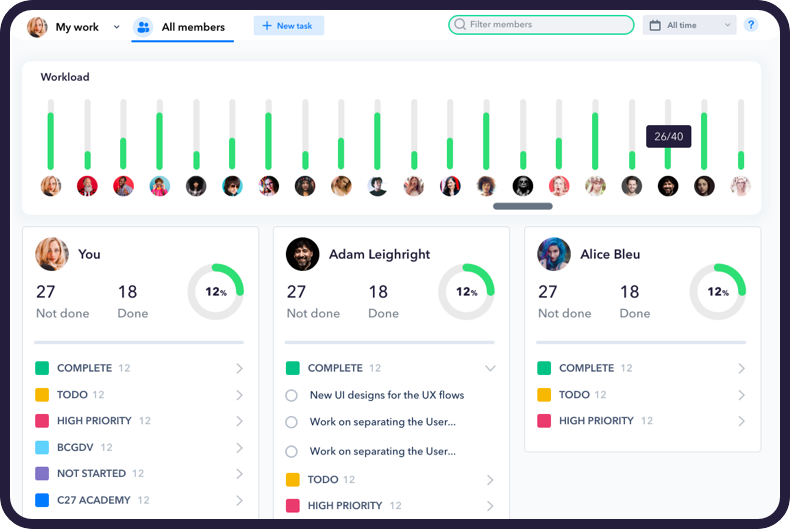How to Give Team Feedback and Constructive Criticism
To effectively build a team and make it productive, you need to be good at giving team feedback. All successful organizations know that managing team feedback can’t be merely an annual exercise related to increments or bonuses. Importantly, they also know that fostering a culture of constructive criticism in teams is vital to employee engagement.
But what exactly is the difference between team feedback and constructive criticism? Why and when do you give either to an individual or a group? How can you effectively communicate the feedback to increase productivity in your teams? Understanding these will not only raise your team’s productivity but also the productivity of your business.

The importance of providing team feedback and constructive criticism
Whether you’re managing a remote team or onsite employees, it’s time to think beyond the traditional frameworks of annual employee assessments. The primary reason to give timely team feedback and constructive criticism is that projects have become more complex.
Think of any domain and you’ll realize that there’s more information than ever before for employees to handle. There are ever-changing channels that team members have access to. Few individuals would have the expertise to deal with the sheer scale of information coming their way in the form of reports, insights, case studies, etc.
Secondly, projects have also become bigger with shorter timelines to execute them. Gone are the days when a marketing team would have months to prepare for a holiday campaign. Now they have to create multiple campaigns every year that take into account customer preferences and competition.
The third reason is that the number of individuals and teams involved in any project has also increased significantly. Real-time collaboration with a steady input of information across domains can pose serious challenges to even trained individuals.
How do these issues relate to team feedback and constructive criticism? Because these challenges can affect the quality of the work of employees. They may not have the necessary expertise or they could be used to a different system. As a leader, it’s your role to steady the ship by providing the right feedback at the right time.
What is constructive criticism?
Offering constructive criticism is a crucial component of team management. Criticism becomes constructive when it’s a balanced approach that acknowledges both the positive and negative attributes of an individual’s work along with suggestions to improve.
Negative criticism focuses only on what the individual did wrong. It can be generic, malicious, and with an intent to reduce the act to the individual and remove any chance of growth.
Constructive criticism is specific, actionable, and encouraging. It doesn’t label an individual by what they did wrong. It sees that act as an aberration that isn’t in sync with the individual’s potential.
In constructive criticism, you acknowledge what the individual did as wrong but your primary goal is to improve their performance. It is different from the standard positive-criticism-positive approach where you sandwich the negative feedback between positive statements. That comes across as disingenuous and leads to distrust and a lack of engagement.

5 ways to offer team feedback and constructive criticism
These best practices for managing team feedback will help foster constructive criticism in your teams.
1. Make it regular and not just annual
If performance is regular, why shouldn’t feedback be?
Annual reviews are unproductive for both individuals and organizations. These one-on-meetings lead to feedback that has lost all its relevance. Specific suggestions on performance that an employee would have valued after a project is meaningless when given months later. They also tend to be perfunctory more than anything else.
Regular, informal meetings can be more accurate in tracking an employee’s performance. These are linked to specific tasks and are greatly appreciated by employees because they offer actionable suggestions.
Frequent interactions are also more honest because they’re organically linked to tasks. For example, you might notice how an employee hands over their reports a day or two late. Or you might observe how an individual is being less direct in client meetings.
These criticisms will be less confrontational because the employee would know what they did wrong. When you offer immediate feedback with constructive criticism on how they can improve, it not only leads to better behavior at an individual level but also helps the organization improve its output. That’s what makes them constructive.
2. Be direct and respectful
Managing team feedback is all about giving honest criticism. There’s absolutely no need to be disingenuous by sugarcoating the feedback. That can be hugely counterproductive because the employee may not understand that they did something wrong.
It might also make them question your ability to spot problems, which will undermine their belief in your leadership and the company. Importantly, indirect criticism fails in its most important goal of correcting the wrong and improving performance.
That’s why managers should be more direct in their approach. The way to do it is by first describing the behavior that you want them to improve. State it clearly without leaving any room for doubt. Then, explain why that behavior is important for the individual, the team, and the organization as a whole.
Finally, be specific about the desired change. If you want someone to quote the right sources in a report, mention the sources that you’re comfortable with. If you want an individual to be more creative in their campaigns, offer examples of other advertising campaigns.

3. Be positive
Employees can’t be blamed if they believe that they’re only remembered when something goes wrong. In several organizations, feedback, by definition, is negative and dispiriting. To effectively manage team feedback, it’s important to praise employees for their performance.
While complimenting people, make sure that it’s specific feedback. This helps them repeat that performance. Also, try to give it immediately after the act. This is another reason to give frequent feedback.
Use positive language directly relating to the task. If someone has handed in a well-written report, commend them on their language and attention to detail. If someone has thought of a creative idea, praise them for their imagination and how the campaign will be different due to their efforts.
Even when giving constructive criticism for a negative performance, it’s important to focus on that particular incident. Don’t draw parallels to everything else the employee would have done. They should know that they did something wrong and that there’s scope for improvement. Make them feel part of your organizational plan and they will be more engaged and willing to improve.
4. Give personalized feedback
Generalized feedback can be meaningless because it might relate to a whole team or project. For example, when you say that someone’s an excellent team player, it’s unclear what attribute you’re referring to. It also makes it difficult for the person to repeat that set of behaviors.
To successfully manage team feedback, make it specific and relatable. It should be about the individual, their performance, and the challenges they would have faced. This also makes your feedback credible and genuine.
Of course, to do it well, you would have to understand the employee’s contributions. You’ll have to know what they delivered, how they have been consistent, or how they go beyond the company’s expectations. This tells the employee that the organization values them enough to know about their individual efforts.
Personalized feedback encourages people to be productive. When they realize that the leadership understands what they bring to the table, there’s an incentive to keep doing it. This is one of the most effective ways to build productive and cohesive teams.
5. Make holistic assessments
It’s important to give personalized feedback but it’s equally important to have a holistic assessment of an employee’s performance. What this means is that an employee’s performance should always be assessed against the larger goals of the organization.
Holistic assessments help employees realize how their individual performance impacts the business. When they know that what they’re doing has a demonstrable effect on the organization as a whole, they would be more inclined to improve their performance.
Managers should help employees understand their specific roles and responsibilities and communicate how their efforts affect both their teams and the business. Similarly, make sure that all teams in the system understand their impact on the organization.
If you’re worried about constructive criticism in teams, convey how a negative trait or behavior is affecting the business. This gives individuals greater incentives to correct their wrongs. Telling someone that they need to improve because their performance negatively affects others can be powerfully motivating.

In short
Knowing how to give team feedback and foster constructive criticism in teams can remove delays, improve productivity, and increase employee engagement. The right software can help you dramatically improve internal communication and collaboration, and provide a channel for timely feedback.
Heycollab is a project management tool built for teams like yours. With a free 14-day trial you can try out all the cool features. To get started visit https://heycollab.com/

